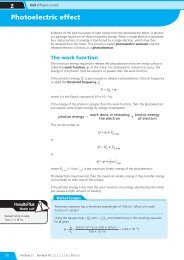Provide female and male intimate waxing services - Pearson Schools
Provide female and male intimate waxing services - Pearson Schools
Provide female and male intimate waxing services - Pearson Schools
You also want an ePaper? Increase the reach of your titles
YUMPU automatically turns print PDFs into web optimized ePapers that Google loves.
Long-term hair removal options<br />
Epilation<br />
Epilation is an advanced treatment at NVQ Level 3. It is<br />
permanent removal of the hair <strong>and</strong> requires considerable skill<br />
<strong>and</strong> training. A small needle is inserted into the hair follicle<br />
<strong>and</strong> a current is passed through the needle. If the hair is in<br />
the anagen stage of hair growth, the dermal papilla has the<br />
blood supply sealed, preventing a new hair from growing.<br />
Epilation is a permanent method of hair removal only if the<br />
hair is in the correct growth stage. The client will need to be<br />
aware that a number of treatments may be required before all<br />
the hair is permanently removed. Epilation of the pubic hair<br />
can be expensive but is essential for transgender clients who<br />
are undergoing treatment to change sex. Advanced epilation<br />
technicians may offer epilation to the scrotal sack <strong>and</strong><br />
perineum, as referred by a physician prior to surgery to alter<br />
the genitals. This ensures the area is permanently hair free.<br />
Laser hair removal<br />
Laser (light amplification by stimulated emission of radiation)<br />
hair removal is usually carried out in specialist clinics<br />
rather than local salons <strong>and</strong> treatments can be costly. As<br />
with epilation, a number of treatments may be required<br />
for successful hair removal. The laser treatment involves<br />
a laser beam being passed down a h<strong>and</strong>held instrument,<br />
the laser energy is converted into heat, <strong>and</strong> this heat<br />
destroys the hair follicle <strong>and</strong> dermal papilla preventing the<br />
hair from regrowing. You can only treat small areas at a<br />
time, which makes it time-consuming. It generates a lot<br />
of heat in a concentrated area <strong>and</strong> it must be cooled, <strong>and</strong><br />
there is a risk of side effects. The treatment causes a slight<br />
stinging sensation, especially in sensitive areas. This has<br />
also become ever more popular for the pubic region as an<br />
eventual permanent solution to hair growth.<br />
IPL<br />
IPL (intense (variable) pulsed light) uses a rapid series of<br />
intense light flashes, to create heat to destroy the dermal<br />
papilla; these bursts of light ensure the target reaches its<br />
aspired temperature with few side effects to the surrounding<br />
tissue. The light is selectively absorbed by melanin in the<br />
hair <strong>and</strong> converted to heat, it travels through the hair to<br />
the follicle where it breaks down the constituent protein (it<br />
loses its natural configuration) effectively destroying the hair<br />
<strong>and</strong> rendering it incapable of regrowing. There are minimal<br />
side effects <strong>and</strong> discomfort, with a significant reduction in<br />
bruising, redness or crusting of the skin <strong>and</strong> no need to apply<br />
topical anaesthetic.<br />
Other practical units<br />
Ingredients <strong>and</strong> composition of<br />
<strong>waxing</strong> products<br />
There are many excellent types of wax available, with<br />
various ingredients <strong>and</strong> different effects. Wax is classed<br />
according to its working temperature. The temperatures<br />
below are supplied courtesy of Bellitas Ltd, beauty suppliers<br />
known for their Strictly Professional waxes. Manufacturers’<br />
instructions will vary with different products, so always refer<br />
to the recommended temperatures <strong>and</strong> heating units for<br />
maximum benefit <strong>and</strong> safety.<br />
Type of wax Working temperature<br />
<br />
<br />
<br />
<br />
<br />
<br />
Type of wax <strong>and</strong> its working temperature (Source: Bellitas Ltd)<br />
Ingredients<br />
Look back at your Level 2 <strong>waxing</strong> unit to remind yourself of<br />
the ingredients of wax (page 317 in Unit BT6 if you took your<br />
Level 2 examinations before 2011, pages 407–454 in Unit<br />
B6 if aer this time).<br />
Recent developments in wax formulation have seen<br />
companies starting to add essential oils other than the<br />
well-known tea-tree oil to their wax recipes. Lavender, for<br />
example, has healing <strong>and</strong> soothing properties <strong>and</strong> has<br />
long been used to treat burns <strong>and</strong> irritations. Other natural<br />
ingredients can also enhance the wax, such as aloe vera,<br />
which has soothing, moisturising <strong>and</strong> healing properties, <strong>and</strong><br />
is suitable for sensitive skin types.<br />
Types of wax <strong>and</strong> <strong>waxing</strong> products<br />
Every wax product is different <strong>and</strong> requires different care in<br />
its application, storage <strong>and</strong> use. You must know the main<br />
ingredients of the wax <strong>and</strong> underst<strong>and</strong> its properties <strong>and</strong> how<br />
For your portfolio<br />
<br />
<br />
<br />
<br />
<strong>Provide</strong> <strong>fe<strong>male</strong></strong> <strong>and</strong> <strong>male</strong> <strong>intimate</strong> <strong>waxing</strong> <strong>services</strong> Unit B26/B27<br />
7

















